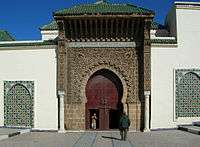Ismail Ibn Sharif
| Moulay Ismail ibn Sharif | |
|---|---|
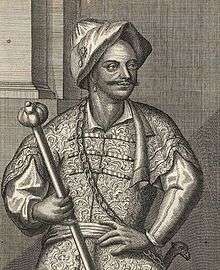 Portrait of Ismail ibn Sharif | |
| Sultan of Morocco | |
| Reign | 1672–1727 |
| Coronation | 14 April 1672[1] |
| Predecessor | Al-Rashid |
| Successor | Abu'l Abbas Ahmad |
| Born |
1634 Rissani, Emirate of Tafilalt |
| Died |
22 March 1727 Meknes, Morocco |
| Spouse |
1) Khnata bent Bakkar 2) Lalla Aisha Mubarka 3) Lalla Umm al-Iz at-Taba [Umelez Ettaba] (d. after 1721) 4) Lalla Bilqis 5) Lalla Halima as-Sufianiya [Hazezas] 6) a lady from the al-Taligiyya clan 7) Lalla Alwa 8) Mrs. Shaw, an Irishwoman [2] |
| Issue | 525 sons and 342 daughters |
| House | Alaouite Dynasty |
| Father | Sharif ibn Ali |
Moulay Ismail ibn Sharif (Arabic: مولاي إسماعيل بن الشريف ابن النصر) (1634– 22 March 1727), reigned 1672–1727[3], was the second ruler of the Moroccan Alaouite dynasty. He is also known in his native country as the "Warrior King".
Reign
He ruled from 1672 to 1727, succeeding his half-brother Moulay Al-Rashid who died after a fall from his horse. At the age of twenty-six, Moulay Ismaïl inherited a country weakened by internal tribal wars and royal successions. After al-Rashid's death on April 9, 1672, the city of Marrakesh refused to swear allegiance to Ismail, who at the time served as viceroy in Meknes. Instead, the people of Marrakesh opted for his nephew Ahmad ibn Muhriz.[4][5] This prompted Ismail to march south where he defeated Ahmad and entered Marrakesh in June 1672. But Ibn Muhriz escaped and fled to the Sous region in southern Morocco, whence he would return in 1674 and retake Marrakesh. Once in control he set about fortifying the city.
Ismail was forced to return and lay a two-year siege on the city. Marrakesh finally fell to assault in June 1677, and this time Ismail sacked the city.[5][6] Ibn Muhriz, however, again escaped to the Sous. In the following years he would make several more attempts to retake Marrakesh, before he was finally tracked down and killed in 1687.[5]
He has been given the epithet "The bloodthirsty"[7] for his legendary cruelty. In order to intimidate rivals, Ismail once ordered that his city walls be adorned with 10,000 heads of slain enemies. Legends of the ease in which Ismail could behead or torture laborers or servants he thought to be lazy are numerous. During the half century of Ismail's rule, it is estimated he killed 30,000.[8]
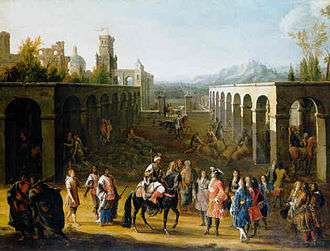
During Moulay Ismaïl's reign, Morocco's capital city was moved from Fez to Meknes where he carried out an extensive building program that resulted in the construction of numerous gates, mosques, gardens and madrases. Some of the stones were taken from the ancient Roman ruins at Volubilis.[9]
Military campaigns
Moulay Ismaïl is noted as one of the greatest figures in Moroccan history. He fought the Ottoman Turks in 1679, 1682 and 1695/96. After these battles Moroccan independence was recognized. Another problem was the European occupation of several seaports where in 1681 he retook al-Mamurah (La Mamora) from the Spanish, which he renamed the city al-Mahdiya.[10] His representative Kaid Omar had told the Spaniards that they would not be sold into slavery if they surrendered unconditionally "Although they would be captives they would spend their days without working, until the first redemption." However Moulay Ismaïl saw no reason to honour Kaid Omar's promises and had no intention of allowing the 2,000 Spanish captives from al-Mamurah to be redeemed so they, including fifty "poor girls and women", were forced to walk to Meknes as booty along with their possessions, arms and artillery (88 bronze cannons, 15 iron cannons, fire-pots, muskets and gunpowder) which was wrote Germain Mousette "more than he had in the rest of his kingdom".[11]
Later in 1684 he also conquered Tangier from the English (after they demolished their fortifications and harbour in the winter of 1683 then abandoned the former Portuguese colony in February 1684 because of his assaults on it) and in 1689 captured Larache from the Spanish. To celebrate the triumph Moulay Ismaïl issued an edict banning the wearing of black shoes because the Spanish were said to have introduced the custom into Morocco when they first acquired Larache in 1610. The mufti of Fez was so elated by the victory he wrote, "How many infidels at dusk have had their heads severed from their bodies! How many were dragged away with the death rattle in their throats! For how many throats have our Lance's been as necklaces! How many lance-tips were thrust into their breasts!"
Over 150,000 men from sub-Saharan Africa served in his elite Black Guard,[12] which helped Ismail to conquer the whole Morocco from European kingdoms except two fortresses in peninsula, Ceuta and Melilla.[13] By the time of Ismail's death, the guard had grown tenfold, the largest in Moroccan history.
He also founded Jaysh al-Rifi, an independent army of Berber tribesmen from the eastern Rif. Jaysh al-Rifi played an important role in the 17th-century Moroccan wars against Spanish colonization.[14]
Diplomacy
It is claimed Moulay Ismaïl had excellent relations with Louis XIV of France, the enemy of Spain, to whom he sent ambassador Mohammad Temim in 1682. However, throughout his reign he held many thousands of French slaves and concubines as a result of the Barbery pirates piracy whom he refused to release without exorbitant amounts and rich gifts, so this is doubtful. It is claimed there was cooperation in several fields including having French officers training the Moroccan army and advised the Moroccans in the building of public works but this is equally doubtful unless the officers concerned were captive slaves who co-operated to avoid the day-to-day tortures Moulay Ismaïl employed to force Christians to "turn Moor" (convert to Islam).[15]
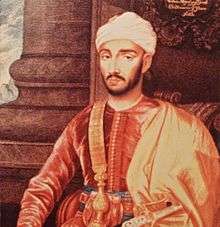
In 1682 he sent Mohammed Tenim as an ambassador to Louis XIV, and he even made an offer of marriage to Louis XIV's beautiful "legitimised" daughter Marie Anne de Bourbon. Marie Anne refused.
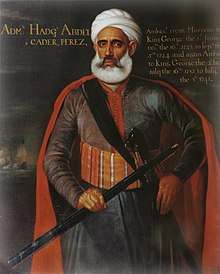
Legacy
Moulay Ismaïl is alleged to have fathered a total of 867 children, including 525 sons and 342 daughters by 1703, with his 700th child being born in 1721. It is estimated that he had 2,000 concubines.[17][18][19][20][21][22] This is widely considered the record number of offspring for any man throughout history that can be verified.
After Moulay Ismaïl's death at the age of eighty (or around ninety by the 1634 birthdate) in 1727, there was another succession battle between his surviving sons. His successors continued with his building program, but in 1755 the huge palace compound at Meknes was severely damaged by an earthquake. By 1757 his grandson, Mohammad III moved the capital to Marrakesh.
Ismail ibn Sharif is mentioned in chapter 11 of Voltaire's Candide. The character of the sultan in the novel "The Sultan's Wife" by Jane Johnson is based on Moulay Ismaïl. In Marguerite Henry's King of the Wind "Sultan Mulai Ismael, Emperor of all Morocco" sends six Arabian horses to Louis XV, "the boy-King of France."[23]
See also
Notes
Part of a series on the |
|---|
| History of Morocco |
 |
|
Related topics
|
|
|
- ↑ "Morocco (Alaoui Dynasty)". www.usa-morocco.org. Retrieved 10 April 2018.
- ↑ "MOROCCO3".
- ↑ Abun-Nasr, J.M., A History of the Maghrib in the Islamic Period, page 230. Cambridge University Press, 1987
- ↑ Julien (1931: p.228–9); El Fasi (1992: p.114)
- 1 2 3 Cenival (1913-36: p.303; 2007: p.328)
- ↑ Julien (1931: p.229); El Fasi (1992: p.114)
- ↑ "Some magical Moroccan records". Guinness World Records. Guinness World Records Limited. March 3, 2008. Retrieved March 20, 2010.
- ↑ Lawrence, Paul R. (2010). Driven to Lead: Good, Bad, and Misguided Leadership. John Wiley and Sons. ISBN 0-470-62384-5.
- ↑ C.Michael Hogan, Volubilis, Megalithic Portal, ed. A. Burnham (2007)
- ↑ Lévi-Provençal, Evariste. "Al Madīya". In Houtsma, Martijn Theodoor. E. J. Brill's First Encyclopaedia of Islam: 1913 – 1936, Volume 5, L – Moriscos (1987 reprint ed.). p. 122. ISBN 978-90-04-08494-0.
- ↑ Vitkus, Matar, Daniel J., Nabil I. (2001). Piracy, Slavery, and Redemption: Barbary Captivity Narratives from Early Modern England (Illustrated, Annotated ed.). Columbia University Press; Quoting Al Qadiri's Nashr al Mathani. p. 139. ISBN 0231119054. Retrieved 15 November 2015.
- ↑ "...A la fin du règne de Moulay Ismaïl, qui resta au pouvoir pendant 57 ans, la garde noire comptait 150000 combattants...", p.39 of "Des Tranchés de Verdun à l'église Saint Bernard" by Bakari Kamian edition KARTHALA
- ↑ Fage, Tordoff, John, William (2013). A History of Africa (revisioned ed.). Routledge. p. 182. ISBN 1317797272. Retrieved 15 November 2015.
- ↑ * James Brown (2001). ''Crossing the Strait: Morocco, Gibraltar and Great Britain in the 18th and 19th centuries''.
- ↑ Milton, Giles. White Gold: the Extraordinary Story of Thomas Pellow and North Africa's One Million European Slaves. Hodder. p. 316. ISBN 0 340 89509 8.
- ↑ In the lands of the Christians by Nabil Matar, back cover ISBN 0-415-93228-9
- ↑ "Sultan of Schwing: How Moroccan Ruler Could Sire 1,000 Kids Revealed". livescience.com. Retrieved 10 April 2018.
- ↑ johnblack. "How the Sultan Moulay Ismail of Morocco Sired 1,000 Children". ancient-origins.net. Retrieved 10 April 2018.
- ↑ "Legendary Moroccan ruler COULD have had 1,100 children". dailymail.co.uk. Retrieved 10 April 2018.
- ↑ "The most children produced by human females versus males". wordpress.com. 27 June 2012. Retrieved 10 April 2018.
- ↑ "All my 888 children". Psychology Today. Retrieved 10 April 2018.
- ↑ "Is it physically possible for a man to sire over 800 children? - Seriously, Science?". discovermagazine.com. 18 February 2014. Retrieved 10 April 2018.
- ↑ Henry, Marguerite (2006). King of the Wind: The Story of the Godolphin Arabian. Aladdin: Reissue edition. pp. 48, 50. ISBN 1416927867.
References
- Abum-Nasr, Jamil M. (1987). A History of the Maghrib in the Islamic Period.
- Pennell, C.R. (2000). Morocco Since 1830.
- Bakari Kamian. (2001). Des Tranchés de Verdun à l'église Saint Bernard.
- Vitkus, Matar, Daniel J., Nabil I. (2001). Piracy, Slavery, and Redemption: Barbary Captivity Narratives from Early Modern England
External links
| Wikimedia Commons has media related to Moulay Ismail. |
- (in Arabic) Muslim rulers at hukam.net
- (in Arabic) Evolution is over
| Preceded by Al-Rashid |
Sultan of Morocco 1672–1727 |
Succeeded by Ahmad |
